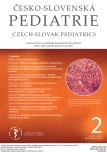It's time to break up with a pediatrician – transfer pediatric patients to care of a general practitioner for adults
Authors:
Ľ. Jakušová; Z. Lietavová; Peter Bánovčin
Authors‘ workplace:
Klinika detí a dorastu, Jesseniova lekárska fakulta Univerzity Komenského v Bratislave, Univerzitná nemocnica Martin, Slovenská, republika
Published in:
Čes-slov Pediat 2021; 76 (2): 81-84.
Category:
Overview
In this text the authors are dealing with the issues of transitioning from pediatrician care into the primary health care for adults. They remark on the role of doctors in this transition process, they point to the obstacles, and present several regulations to improve this process. This process means changing from pediatric health care under parental supervision to independent health care aimed directly at the patient. The most common hindrance is leaving the childhood doctor, with whom the patient has a good long-term relationship.
Keywords:
Adolescents – Young adults – Health care – doctor for children and adolescents – primary care for adults
Sources
1. Brndiarová M, et al. Nephronophthisis type I, left ventricular non-compaction cardiomyopathy and reduced cilia motility-atypical manifestations of one disease. J Nephrol 2020; 33 (1): 183–186.
2. Campbell F, Biggs K, Aldiss SK, et al. Transition of care for adolescents from paediatric services to adult health services. Cochrane Database of Systematic Reviews 2016, Issue 4. Art. No.: CD009794. DOI: 10.1002/14651858.CD009794.pub2.
3. Canadian Association of Pediatric Health Centres (CAPHC), National Transitions Community of Practice (2016). A Guideline for Transition from Paediatric to Adult Health Care for Youth with Special Health Care Needs: A National Approach http://ken.caphc.org/xwiki/bin/view/Transitioning+from+Paediatric+to+Adult+Care/A+Guideline+for+Transition+from+Paediatric+to+Adult +Care.
4. Chabrol B, Jacquin P, Francois L, et al. Transition from pediatric to adult care in adolescents with hereditary metabolic diseases: Specific guidelines from the French network for rare inherited metabolic diseases (G2M). Arch de Pédiatrie 2018; 25: 344-349.
5. Jančinová M, Čiljaková M, Vojtková J, et al. Depresívne a úzkostné symptómy vo vzťahu k spánku u detí a adolescentov s diabetes mellitus 1. typu. Čes-slov Pediat 2019; 74 (1): 22–29.
6. Kuchta M. Pediater a jeho úloha v účinnej prevencii „civilizačných ochorení“. Pediatria pre prax 2016; 17 (1S): 13–14.
7. Lee L, Upadhya KK, Matson P, et al. The status of adolescent medicine: Building a global adolescent workforce. Int J Adolesc Med Health 2016; 28(3): 233–243. doi:10.1515/ijamh-2016-5003.
8. MacLusky I, Keilty K, on behalf of the CTS Pediatric Home Ventilation Guidelines Panel Section 12: Transition from pediatric to adult care. Can J Respiratory, Critical Care, and Sleep Med 2018; 2:sup1.: 83–87, https://doi.org/10.1080/24745332.2018.1494992.
9. McManus M, White P, Barbour A, et al. Pediatric to adult transition: A quality improvement model for primary care. J Adoles Health 2015; 56: 73–78.
10. Michaud PA, Jansen D, Schrier L, et al. An exploratory survey on the state of training in adolescent medicine and health in 36 European countries. Eur J Pediatr 2019; 178: 1559–1565.
11. White PH, Cooley WC. Supporting the health care transition from adolescence to adulthood in the medical home. Pediatrics 2018; 142(5): e20182587.
Labels
Neonatology Paediatrics General practitioner for children and adolescentsArticle was published in
Czech-Slovak Pediatrics

2021 Issue 2
Most read in this issue
- Dysthymia as a less known form of depression: clinical picture and treatment
- Substance and non-substance addictions in adolescence
- Hantavirus hemorrhagic fever with renal syndrome – first pediatric cases in Slovakia
- Dorostové lékařství
